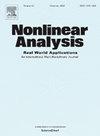Global semigroup of conservative weak solutions of the two-component Novikov equation
IF 1.8
3区 数学
Q1 MATHEMATICS, APPLIED
引用次数: 0
Abstract
We study the Cauchy problem for the two-component Novikov system with initial data in such that the product belongs to . We construct a global semigroup of conservative weak solutions. We also discuss the potential concentration phenomena of , , and , which contribute to wave-breaking and may occur for a set of time with nonzero measure. Finally, we establish the continuity of the data-to-solution map in the uniform norm.
双分量Novikov方程保守弱解的全局半群
我们研究了H1(R)中初始数据为u0,v0的双分量Novikov系统的Cauchy问题,使得乘积(∂xu0)∂xv0属于L2(R)。构造了一个守恒弱解的全局半群。我们还讨论了(∂xu)2dx,(∂xv)2dx和(∂xu)2(∂xv)2dx的潜在集中现象,这些现象有助于破波,并且可能在一段时间内以非零测量发生。最后,我们建立了数据-解映射在一致范数下的连续性。
本文章由计算机程序翻译,如有差异,请以英文原文为准。
求助全文
约1分钟内获得全文
求助全文
来源期刊
CiteScore
3.80
自引率
5.00%
发文量
176
审稿时长
59 days
期刊介绍:
Nonlinear Analysis: Real World Applications welcomes all research articles of the highest quality with special emphasis on applying techniques of nonlinear analysis to model and to treat nonlinear phenomena with which nature confronts us. Coverage of applications includes any branch of science and technology such as solid and fluid mechanics, material science, mathematical biology and chemistry, control theory, and inverse problems.
The aim of Nonlinear Analysis: Real World Applications is to publish articles which are predominantly devoted to employing methods and techniques from analysis, including partial differential equations, functional analysis, dynamical systems and evolution equations, calculus of variations, and bifurcations theory.

 求助内容:
求助内容: 应助结果提醒方式:
应助结果提醒方式:


